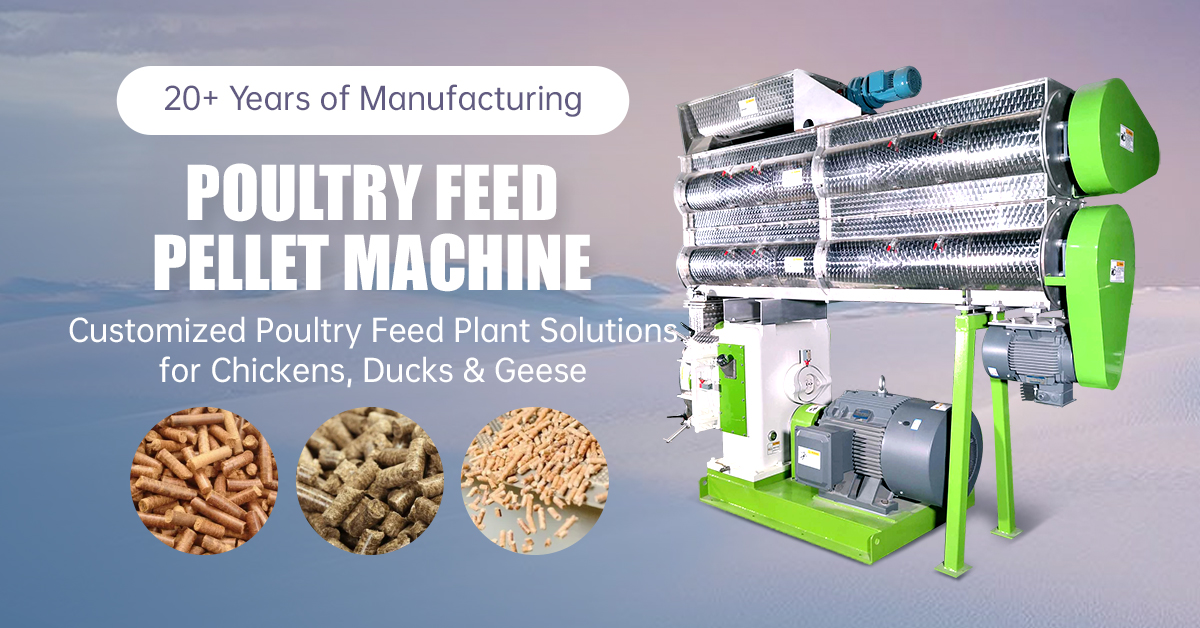Formulating properly formulated, nutritionally balanced duck feed is essential to ensure optimal growth and health of ducks. For today's modern and industrialized society, formulations are very important, but even more important than formulations is how they are used to produce duck feed. Especially for large scale industrialized animal feed production, we need to know more about duck feed formulation, duck feed production equipment configuration and even complete animal feed mill plant.
So let's start by recognizing duck feed formulations and the needs of each stage of production.
Part 1: Duck Feed Formulas by Growth Stage
Duck feed formulations vary depending on the age and function of the ducks (meat, egg-laying, or breeding). Below are sample feed formulations for three main production phases:
1. Ducklings (0–3 Weeks)
| Ingredient | Percentage (%) |
|---|---|
| Corn | 50–55 |
| Soybean Meal | 30–35 |
| Wheat Bran / Rice Bran | 5–7 |
| Fish Meal / Meat Meal | 5–8 |
| Vegetable Oil | 1–2 |
| Premix (Vitamins/Minerals) | 1–1.5 |
| Dicalcium Phosphate | 0.5–1.0 |
| Salt | 0.3 |
Protein: 20–22% | Energy: 2800–2900 kcal/kg
2. Grower Ducks (4–8 Weeks)
| Ingredient | Percentage (%) |
|---|---|
| Corn | 55–60 |
| Soybean Meal | 20–25 |
| Wheat Bran / Rice Bran | 8–10 |
| Fish Meal / Meat Meal | 3–5 |
| Vegetable Oil | 1–1.5 |
| Premix | 1–1.2 |
| Dicalcium Phosphate | 0.5–0.8 |
| Salt | 0.3 |
Protein: 16–18% | Energy: 2900–3000 kcal/kg
3. Laying Ducks (8+ Weeks)
| Ingredient | Percentage (%) |
|---|---|
| Corn | 50–55 |
| Soybean Meal | 18–20 |
| Wheat Bran | 10–12 |
| Fish Meal / Meat Meal | 3–5 |
| Shell Grit / Limestone | 6–8 |
| Vegetable Oil | 1–1.5 |
| Premix | 1–1.2 |
| Dicalcium Phosphate | 0.5–0.8 |
| Salt | 0.3 |
Protein: 16–18% | Calcium: 2.5–3.5%
Functional Role of Common Ingredients
| Ingredient | Function |
|---|---|
| Corn | Primary energy source |
| Soybean Meal | Main protein source |
| Bran | Provides fiber and moderate energy |
| Fish/Meat Meal | Rich in amino acids and digestible protein |
| Vegetable Oil | Energy and fatty acids |
| Limestone/Shell Grit | Boosts calcium for eggshell formation |
| Premix | Supplies vitamins and trace minerals |
| Salt | Electrolyte balance and palatability |
Then the more important thing is the animal feed mill plant. How to build a complete animal feed production line? How to start duck feed pellet production with these equipments properly? RICHI Machinery not only gives you complete production plan and equipment configuration, but also, we completely customize special production line for duck feed pellets according to the different requirements of our customers, such as different formula situation, different output situation, different plant size and even the budget situation of our customers.
Animal feed processing plants process raw materials into finished feed through several stages. Firstly, the raw materials are received and cleaned, and then they are ground into fine particles. The ground ingredients are then evenly mixed and conditioned with moisture and heat. The conditioned mixture is compressed into pellets using special pellet mills for animals. These pellets are cooled and hardened and then sieved to remove fines. Finally, the finished feed is packaged for direct use and distribution. Specialized equipment is used at each stage to ensure efficiency and quality in feed production.
⚙️ Part 2: Duck Feed Production Process With Feed Mill Equipment
To manufacture the formulas above efficiently, a complete animal feed pellet production line follows a systematic production process using specialized machines. 
- Raw Material Cleaning
- Clean grains using a drum pre-cleaner and magnetic separator to remove impurities like stones and iron particles.
- Grinding System
- Use a hammer mill to crush ingredients to the required fineness. Fine grinding is crucial for young ducks.
- Batching & Dosing
- Weigh each ingredient precisely with an automatic batching system, ensuring the correct ratio for every formula.
- Mixing System
- Uniformly mix powders, oils, and additives using a ribbon mixer or double-shaft paddle mixer.
- Pelletizing Section
- Compress the mash into pellets using a ring die pellet machine. Pellet diameter can range from 2 to 5 mm depending on duck age.

- Cooling Equipment
- Cool the hot pellets in a counter-flow cooler to room temperature, increasing hardness and storage stability.
- Screening & Crumbling
- Remove fines with a screener. For ducklings, use a crumbler to break larger pellets into mini-pellets.
- Packaging System
- Weigh and bag finished pellets using an automatic packing scale. Bags are typically 20–50 kg in size.
Sample Duck Feed Pellet Plant Configuration (5T/H Capacity)
| Section | Equipment |
|---|---|
| Cleaning | Drum cleaner, magnetic separator |
| Grinding | Hammer mill (22 kW) |
| Batching | 6–8 bins with PLC dosing |
| Mixing | Paddle mixer (500–1000 kg/batch) |
| Pelletizing | SZLH320 or SZLH350 feed pellet machine |
| Cooling | Counter-flow pellet cooler |
| Crumbling | Double roller crumbler (optional) |
| Packing | Auto bagging and sewing system |
Contact us to start building your animal feed mill Plant right away!
Whether you're raising ducklings, growers, or laying ducks, consistent feed quality is key to health and productivity. With a scientifically formulated recipe and the support of a modern feed mill plant, you can achieve high performance, cost-efficiency, and product consistency. RICHI Machinery provides full turnkey solutions for duck feed production, from equipment supply to plant design and technical training—ensuring your success from feed to farm.


